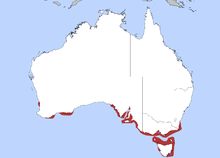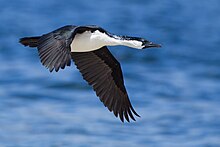Black-faced cormorant: Difference between revisions
→References: Add authority taxa. |
Rescuing 1 sources and tagging 0 as dead. #IABot (v1.2.6) |
||
| Line 33: | Line 33: | ||
==References== |
==References== |
||
{{Reflist}} |
{{Reflist}} |
||
* BirdLife International (2006) Species factsheet: ''Phalacrocorax fuscescens''. Downloaded from http://www.birdlife.org on 14 November 2006 |
* BirdLife International (2006) Species factsheet: ''Phalacrocorax fuscescens''. Downloaded from http://www.webcitation.org/5QE8rvIqH?url=http%3A%2F%2Fwww.birdlife.org on 14 November 2006 |
||
* Johnsgaard, P. A. (1993). ''Cormorants, Darters, and Pelicans of the World''. Washington: Smithsonian Institution Press. ISBN 1-56098-216-0 |
* Johnsgaard, P. A. (1993). ''Cormorants, Darters, and Pelicans of the World''. Washington: Smithsonian Institution Press. ISBN 1-56098-216-0 |
||
* Marchant, S.; & Higgins, P.J. (Coordinators). (2000). ''[[Handbook of Australian, New Zealand and Antarctic Birds]]. Vol.1: Ratites to Ducks''. Oxford University Press: Melbourne. ISBN 978-0-19-553068-1 |
* Marchant, S.; & Higgins, P.J. (Coordinators). (2000). ''[[Handbook of Australian, New Zealand and Antarctic Birds]]. Vol.1: Ratites to Ducks''. Oxford University Press: Melbourne. ISBN 978-0-19-553068-1 |
||
Revision as of 12:46, 3 November 2016
| Black-faced cormorant | |
|---|---|

| |
| Scientific classification | |
| Kingdom: | |
| Phylum: | |
| Class: | |
| Order: | |
| Family: | |
| Genus: | |
| Species: | P. fuscescens
|
| Binomial name | |
| Phalacrocorax fuscescens (Vieillot, 1817)
| |

| |
| Distribution of the black-faced cormorant | |


The black-faced cormorant (Phalacrocorax fuscescens), also known as the black-faced shag, is a medium-sized member of the cormorant family. Upperparts, including facial skin and bill, are black, with white underparts. It is endemic to coastal regions of southern Australia.
Ecology
The black-faced cormorant feeds largely on small coastal fish, diving in depths up to 12 m. Fish of lengths up to 50 cm have been observed to be taken. The birds sometimes forage in flocks, apparently in an organised way.
Range
It is found along much of the southern coast of Australia from eastern Victoria to Cape Leeuwin, Western Australia, as well as around the coast of Tasmania and the islands of Bass Strait.
Habitat
Unlike the other cormorants found around the Australian continent, the habitat of the black-faced cormorant is exclusively coastal and marine.
References
- BirdLife International (2006) Species factsheet: Phalacrocorax fuscescens. Downloaded from http://www.webcitation.org/5QE8rvIqH?url=http%3A%2F%2Fwww.birdlife.org on 14 November 2006
- Johnsgaard, P. A. (1993). Cormorants, Darters, and Pelicans of the World. Washington: Smithsonian Institution Press. ISBN 1-56098-216-0
- Marchant, S.; & Higgins, P.J. (Coordinators). (2000). Handbook of Australian, New Zealand and Antarctic Birds. Vol.1: Ratites to Ducks. Oxford University Press: Melbourne. ISBN 978-0-19-553068-1

